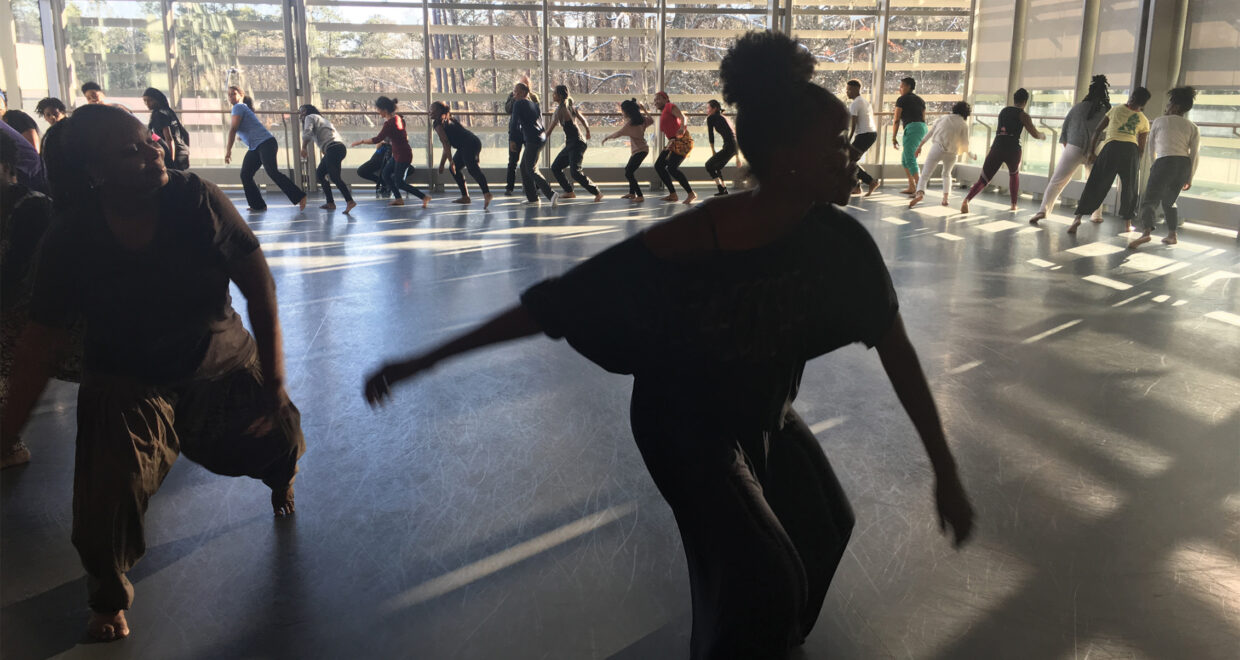Cartographies of Movement
Curated by DRJ Editorial Fellows Sariel Golomb, Jennifer Ligaya Senecal, and Emily Wieder, and inspired by the DSA conference call for papers “Cartographies of Movement,” this digital collection showcases Dance Research Journal articles that engage with kinesthetic and epistemological sites of indigeneity. The three subdivisions narrate the general movement of peoples and ideas at sites of origin, across countries, and beyond geographic or imagined borders. Each article in the “Rooted in Indigeneity” section addresses performance as a means of grounding specific Indigenous cultural beliefs. The section “Mimesis, Transition, and Cross-Pollination” echoes the tensions and instabilities of a migration during which roots are transplanted and seeds dispersed in new locations. Finally, “Charting New Cartographies” explores site specificity and proposes new means of experiencing and teaching colonial histories. These authors orient themselves toward the future while they imagine dance as a way to chart temporal, spatial, and pedagogical terrain.
The first four articles explore the intersection of dance, rootedness, and indigeneity, revealing diverse approaches within the realm of performance. Tria Blu Wakpa’s “Culture Creators and Interconnected Individualism” delves into Rulan Tangen’s choreography, in which each movement weaves a figurative basket, much like those created by the dancer herself, Anne Pesata, a fifth-generation basket weaver and Jicarilla Apache woman. Although inspired by the Jicarilla Apache Nation, the dance is performed globally to evoke parallel experiences across Indigenous cultures. The motif of weaving reappears in Sam Mitchell’s and Julie Burelle’s dialogue on Dee(a)r Spine, which was performed on Kumeyaay territory. Their conversation emphasizes corporeality as a means of repairing Indigenous memory and fostering kinship. Rebekah Kowal’s work on Maria Tallchief explores the Americanization of ballet and expands the notion of “American” to include North American Indigenous cultures. The fusion of Indigenous and colonial influences continues to be discussed in Victoria Fortuna’s “Dancing Argentine Modernity.” Focusing on Buenos Aires concert stages, Fortuna examines modern dance as marking and unmarking of Latin American origins, thus blurring boundaries between identities and dance genres.
The next five articles engage with the messy processes by which identities and cultural practices collide: from confrontation to adaptation, parody, hybridity and appropriation. Adriana Cruz-Manjarrez introduces us to danzas chuscas, the comedic dances practiced across Mexican indigenous and mestizo villages, and in particular those of the Zapotec village of Yalálag, which, in the past thirty years, have come to parody the archetypical behaviors of Yalaltecos living in the United States. Cruz-Manjarrez argues that physical comedy presents a way to confront the instability and change that migration brings to group identities. Another article exploring the translation of Mexican representation is K. Mitchell Snow’s, which takes us back to the early-twentieth century “Aztec” dances of vaudeville theater. These problematic representations of Mexico’s past drew in equal parts from Orientalist tropes and American Manifest Destiny ideology, but were successfully challenged as Mexican emigre dancers offered new representations of their heritage onstage. Idoia Murga Castro also focuses upon the early-twentieth century through the figure of Antonia Mercé (also known as La Argentina)and her 1929 visit to Manila, Philippines, as part of a fabrication of a global Hispanidad through symbolism and gesture. Yet Murga Castro’s case study is also noteworthy for its convergence of narratives surrounding Spanish dance at a moment in time where it was considered a practice of both the colonizing and the colonized, given its racialized and exotic reputation during European Romanticism. Returning us to contemporary stages, Ketu Katrak considers South African artist Jay Pather’s site-specific Cityscapes (2002) as an avant-garde exploration of racialized discord in South Africa and the political legacies of apartheid through a distinct focus on space, access, and exclusion. Finally, Mats Nilsson traces polska and Lindy Hop as dance forms that have migrated globally, focusing on their life in the Swedish context: he argues that ‘dances do not travel but dancing does” by way of bodily dissemination.
The last set of articles reimagines how we teach coloniality and indigeneity. Melanie Kloetzel proposes the concepts of “site-dance on tour,” “mobility,” and “site performance” as decolonial methods of engaging with the historical complexities of site. Karyn Recollet elaborates on these concepts with a case study, arguing that the Vancouver-based multi-media collective Skookum Sound System presents a radical alternative to colonial cartographies in its video performance Ay I Oh Stomp (2012). Mique’l Dangeli brings our attention near Vancouver, where the artist S7aplek from the Squamish Nation illustrates the role ethics play in Indigenous embodied methodologies for challenging historical settler-colonial territorialization of identities and landscapes. Prarthana Purkayastha offers a model for expanding dance beyond the primacy of Western orientation by highlighting translation and interpretation as methodologies that Indian dancer Uday Shankar employs. Karen Vedel finds in the performances Uropa, Republika, and The Grey People further examples of dances that alter conventional ways of knowing. Vedel explores the embodied experience of migration in each piece and invites us to attend to the potential of the sensorial for reconstructing meaning, particularly when it comes to the definition of “the migrant.” The final text archives conversations among dance scholars participating in the 2020 Collegium for African Diaspora Dance residency. Dasha A. Chapman and Mario LaMothe posit “AfroFem” as diasporic, integrative, and mobile. Together, these articles propose novel directions for the teaching and (un)learning of coloniality through dance.
Each article in this collection contributes to a nuanced understanding of dance as a dynamic and culturally resonant practice, weaving threads of knowledge and identity across different Indigenous contexts. In light of conference themes, we also invite readers to revisit the Winter 2008 Special Issue of Dance Research Journal: Global/Mobile: Re-Orienting Dance and Migration Studies, edited by Paul Scolieri.
Access to the research mentioned (where not already open access) is free across July 2024.






